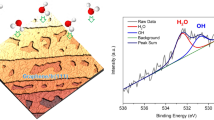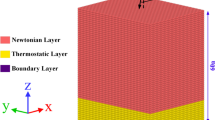Abstract
The purification of graphene from a lead film by irradiating the target with a beam of Xe13 clusters with an energy of 20 eV at different angles of incidence has been studied. Using the method of statistical geometry, it has been shown that, before the bombardment, the double-layer lead film adsorbed on graphene had an irregular structure. Graphene contained divacancies, the edges of which, as well as the edges of the graphene sheet, were hydrogenated. The complete removal of lead from graphene was achieved at the angle of incidence of Xe13 clusters equal to 45°. A major part of the film was separated from graphene in the form of an island, which, after separation, was transformed into a three-dimensional structure. The stresses present in the graphene sheet changed in the course of bombardment, but the stressed state retained after the bombardment was terminated. The type of the distribution of stresses in graphene indicates the absence of enhancement of the stressed state in the course of bombardment. The bombardment at angles of incidence of clusters less than 75° substantially enhances the roughness of graphene. The bombardments in the entire range of the angles of cluster incidence (0°–90°) have resulted in no significant damages in the hydrogenated edges of the graphene sheet.
Similar content being viewed by others
References
S. N. Luoma, “Bioavailability of trace metals to aquatic organisms. A review,” Sci. Total Environ. 28, 1–22 (1983).
W. Hummers and R. Offeman, “Preparation of graphitic oxide,” J. Am. Chem. Soc. 80, 1339–1339 (1958).
L. Zaijan, Y. Yuling, T. Jian, and P. Jiaomai, “Spectrophotometric determination of trace lead in water after preconcentration using mercaptosephadex,” Talanta 60, 123–130 (2003).
M. S. Di Nezio, M. E. Palomeque, and B. S. Fernandez, “A sensitive spectrophotometric method for lead determination by flow injection analysis with on-line preconcentration,” Talanta 63, 405–409 (2004).
D. Kara, M. Alkan, and U. Cakir, “Solvent extraction of copper from aqueous solution with pentaeritrtyl tetrabenzylamine,” Turk. J. Chem. 25, 293–303 (2001).
S. B. Sonawale, Y. V. Ghalsasi, and A. P. Argekar, “Extraction of lead(II) and copper(II) from salicylate media by tributylphosphine oxide,” Anal. Sci. 17, 285–289 (2001).
J. L. Manzoori and A. T. Bavili, “Cloud point preconcentration and flame atomic absorption spectrometric determination of Cd and Pb in human hair,” Anal. Chim. Acta 470, 215–221 (2002).
J. Chen and K. C. Teo, “Determination of cadmium, copper, lead and zinc in water samples by flame atomic absorption spectrometry after cloud point extraction,” Anal. Chim. Acta 450, 215–222 (2001).
S. Yuan, W. Chen, and S. Hu, “Simultaneous determination of cadmium (II) and lead (II) with clay nanoparticles and anthraquinone complexly modified glassy carbon electrode,” Talanta 64, 922–928 (2004).
H. Gao, J. Zhou, M. Lu, W. Fa, and Y. Chen, “First-principles study of the IVA group atoms adsorption on graphene,” J. Appl. Phys. 107, 114311 (2010).
D. Ma and Z. Yang, “First-principles studies of Pb doping in graphene: Stability, energy gap and spin-orbit splitting,” New J. Phys. 13, 123018 (2011).
A. E. Galashev and V. A. Polukhin, “Compaction of a copper film on graphene by argon-beam bombardment: Computer experiment,” J. Surf. Invest. X-ray, Synchr. Neutr. Tech. 8, 1082–1088 (2014).
A. E. Galashev and V. A. Polukhin, “Removal of copper from graphene by bombardment with argon clusters: Computer experiment,” Phys. Met. Metallogr. 115, 697–704 (2014).
A. E. Galashev and O. R. Rakhmanova, “Mechanical and thermal stability of graphene and graphene-based materials,” Phys.-Usp. 57, 970–989 (2014).
A. E. Galashev and A. A. Galasheva, “Molecular dynamics simulation of copper removal from graphene by bombardment with argon clusters,” High Energy Chem. 48, 112–116 (2014).
M. F. Jr. Russo and B. J. Garrison, “Mesoscale energy deposition footprint model for kiloelectronvolt cluster bombardment of solids,” Anal. Chem. 78, 7206–7210 (2006).
M. F. Jr. Russo, C. Szakal, J. Kozole, N. Winograd, and B. J. Garrison, “Sputtering yields for C60 and Au3 bombardment of water ice as a function of incident kinetic energy,” Anal. Chem. 79, 4493–4498 (2007).
E. J. Smiley, N. Winograd, and B. J. Garrison, “Effect of cluster size in kiloelectronvolt cluster bombardment of solid benzene,” Anal. Chem. 79, 494–499 (2007).
Y. Watanabe, H. Yamaguchi, M. Hashinokuchi, K. Sawabe, S. Maruyama, Y. Matsumoto, and K. Shobatake, “Trampoline motions in Xe-graphite (0001) surface scattering,” Chem. Phys. Lett. 413, 331–334 (2005).
J. Tersoff, “Empirical interatomic potential for carbon, with application to amorphous carbon,” Phys. Rev. Lett. 61, 2879–2882 (1988).
S. J. Stuart, A. V. Tutein, and J. A. Harrison, “A reactive potential for hydrocarbons with intermolecular interactions,” J. Chem. Phys. 112, 6472–6486 (2000).
A. E. Galashev and V. A. Polukhin, “Computer study of the physical properties of a copper film on a heated graphene surface,” Phys. Solid State 55, 1733–1738 (2013).
A. E. Galashev and S. Yu. Dubovik, “Molecular dynamics simulation of compression of single-layer graphene,” Phys. Solid State 55, 1976–1983 (2013).
H. Rafii-Tabar, “Modelling the nano-scale phenomena in condensed matter physics via computer-based numerical simulations,” Phys. Rep. 325, 239–310 (2000).
Y. M. Kim and S.-C. Kim, “Adsorption/desorption isotherm of nitrogen in carbon micropores,” J. Korean Phys. Soc. 40, 293–299 (2002).
A. Arkundato, Z. Su’ud, M. Abdullah, and W. Sutrisno, “Study of liquid lead corrosion of fast nuclear reactor and its mitigation by using molecular dynamics method,” Int. J. Appl. Phys. Math. 3, 1–7 (2013).
F.-Y. Li and R. S. Berry, “Dynamics of Xe atoms in NaA zeolites and the 129 Xe chemical shift,” J. Phys. Chem. 99, 2459–2468 (1995).
J. F. Ziegler, J. P. Biersack, and U. Littmark, Stopping and Ranges of Ions in Matter (Pergamon, New York, 1985), Vol. 1.
A. Delcorte and B. J. Garrison, “High yield events of molecule emission induced by keV particle bombardment,” J. Phys. Chem. B 104, 6785–6800 (2000).
F. D. Lamari and D. Levesque, “Hydrogen adsorption on functionalized graphene,” Carbon 49, 5196–5200 (2011).
H. J. C. Berendsen, J. P. M. Postma, W. F. van Gunsteren, A. DiNola, and J. R. Haak, “Molecular dynamics with coupling to an external bath,” J. Chem. Phys. 81, 3684–3690 (1984).
B. Hafskjold and T. Ikeshoji, “Microscopic pressure tensor for hard-sphere fluids,” Phys. Rev. E: Stat., Nonlin., Soft Matter Phys., 66, 011203 (2002).
S. Yu. Davydov, “Energy of substitution of atoms in the epitaxial graphene–buffer layer–SiC substrate system,” Phys. Solid State 54, 875–882 (2012).
Z. H. Jin, H. W. Sheng, and K. Lu, “Melting of Pb clusters without free surfaces,” Phys. Rev. B: Condens. Matter Mater. Phys. 60, 141–149 (1999).
Author information
Authors and Affiliations
Corresponding author
Additional information
Original Russian Text © A.E. Galashev, 2016, published in Fizika Metallov i Metallovedenie, 2016, Vol. 117, No. 3, pp. 258–265.
Rights and permissions
About this article
Cite this article
Galashev, A.E. Molecular-Dynamic Simulation of the Bombardment of a Lead Film on Graphene by Xe13 Clusters. Phys. Metals Metallogr. 117, 246–253 (2016). https://doi.org/10.1134/S0031918X16030054
Received:
Accepted:
Published:
Issue Date:
DOI: https://doi.org/10.1134/S0031918X16030054




